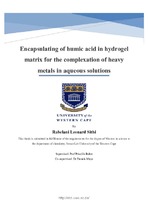| dc.contributor.advisor | Baker, Priscilla | |
| dc.contributor.advisor | Muya, Francis | |
| dc.contributor.author | Sithi, Rabelani Leonard | |
| dc.date.accessioned | 2020-12-09T11:54:21Z | |
| dc.date.issued | 2020 | |
| dc.identifier.uri | http://hdl.handle.net/11394/7714 | |
| dc.description | >Magister Scientiae - MSc | en_US |
| dc.description.abstract | Rapid industrialization growth without appropriate emission standards for discharging
environmental pollutants had exposed the ecosystem to detrimental effect. Due to their
bioaccumulation propensity in organisms, toxicity and non-biodegradable aspect, heavy metal
spoliation is currently a significant ecological obligation. Owing to their natural abundance and
extensive use, cadmium (Cd) and lead (Pb), among different heavy metals, are the predominant
toxic metals. The intrusion of Cd and Pb metal ions into the ecosystem is accomplished by widely
accepted methods such as anticorrosive coating of steel, electronic circuit and batteries. | en_US |
| dc.language.iso | en | en_US |
| dc.publisher | University of Western Cape | en_US |
| dc.subject | Hydrogels (HGL) | en_US |
| dc.subject | Humic acid (HA) | en_US |
| dc.subject | Polysulfone (PSF) | en_US |
| dc.subject | Glutaraldehyde (GA) | en_US |
| dc.subject | Polyvinyl alcohol (PVA) | en_US |
| dc.title | Encapsulating of humic acid in hydrogel matrix for the complexation of heavy metals in aqueous solutions | en_US |
| dc.rights.holder | University of Western Cape | en_US |
| dc.description.embargo | 2023 | |

